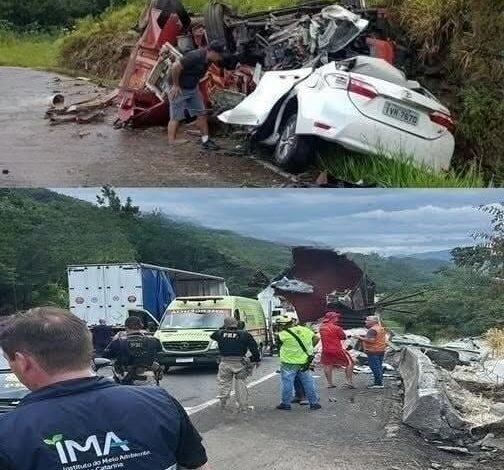The tragedy unfolded on a quiet Tuesday night along BR-251, the long ribbon of asphalt that cuts through the rural countryside of Grão Mogol in northern Minas Gerais. What should have been an ordinary return trip for a group of workers became one of the deadliest crashes the region has faced in recent years. By the time rescue crews finished their work, nine people were dead and twelve more were clinging to life in nearby hospitals.
The passengers were on their way back to Ceará after finishing a work assignment. It was supposed to be just another overnight journey — exhausting, yes, but familiar. The kind of ride where people doze off against the window, whisper about home-cooked meals waiting for them, and count the hours until they can hug their families again.
But somewhere along that dark stretch of highway, everything went catastrophically wrong.
Civil Police investigators arrived quickly, but the scene that greeted them was harrowing. The van was crushed into a twisted shell. A truck sat mangled and facing the wrong direction, its front end obliterated. Shards of glass, scraps of metal, shoes, backpacks, and shattered belongings lay scattered for dozens of meters. Long, jagged skid marks carved across the pavement showed exactly where the violence began.
What forensic experts pieced together was devastatingly simple: the truck crossed into the opposite lane and struck the van head-on.
“It was the determining factor,” forensic specialist Hugo Leonardo said. “The drag marks and tire impressions show the truck moved across the center line. The van had no chance to avoid the impact.”
The collision was so violent that some of the victims died instantly. Others succumbed to their injuries before firefighters could cut them free. Survivors were rushed out in ambulances, some unconscious, others trembling in shock, many unable to process what had just happened.
The crash site pulsed with flashing red and blue lights. Firefighters, paramedics, and police worked through the night, weaving through wreckage and grief, trying to save lives while acknowledging the ones they couldn’t.
As dawn broke, Brazil woke to the heartbreaking news. Among the nine dead was a well-known local singer whose identity was initially withheld. The music community was shattered. Fans posted tributes across social media — grainy concert videos, warm messages, and memories of a voice that had shaped a part of their lives. Colleagues mourned publicly, remembering his kindness, his charisma, and the talent now silenced forever.
Back in Grão Mogol, investigators remained on the scene long after the ambulances drove off. They walked the asphalt, took measurements, photographed everything, and collected fragments of metal and rubber that would later reconstruct a timeline of what went wrong. By mid-morning, tow trucks hauled the destroyed vehicles away, and traffic slowly crept back through the area, though the weight of the tragedy lingered heavily in the air.
The workers in the van had been traveling hundreds of kilometers — fathers, sons, young men early in their careers, people supporting families back home. Some had children eagerly waiting for them. Some had elderly parents depending on their income. All of them were simply trying to return home.
The truck driver survived and was taken to a hospital. Investigators are working to determine whether fatigue, distraction, speeding, or mechanical failure caused the loss of control. Toxicology tests were ordered, and the driver’s account will be a crucial piece of the investigation.
For the victims’ families, the wait for answers feels unbearable. Many arrived in Minas Gerais after traveling across states, forced to identify loved ones, collect belongings, and confront the crushing reality of returning home alone. Local officials are offering assistance with lodging, transportation, and funeral arrangements.
Meanwhile, the twelve injured survivors remain hospitalized — some stable, others still fighting for their lives. Doctors warn that recovery will be long and difficult. The emotional trauma may last even longer.
In Ceará, the shock reverberated deeply. Communities that knew the workers began preparing for multiple funerals. Local leaders expressed their condolences, and many neighborhoods closed businesses early out of respect. Churches scheduled prayer services, and families gathered in living rooms where grief washed through entire households.
As the story spread across Brazil, it reignited discussions about the dangers of long highways like BR-251. Truck accidents on rural routes remain far too common. Locals say that the road has risky curves, unreliable lighting, and long, hypnotic stretches that can lull tired drivers into drifting off. Many truckers push past safe driving hours due to pressure and strict schedules. The issues are not new — but tragedies like this force the conversation back into the national spotlight.
The death of the singer intensified the outrage and sorrow. Radio stations aired tributes all day. Fans shared old recordings. A voice that had filled stages and radios suddenly existed only in memory.
One truth has emerged through the mourning: this accident will not fade quietly. It has reopened urgent conversations about road safety, working conditions, driver fatigue, and the human cost of long-haul labor in Brazil. It has reminded the country of how fragile life is — how fast an ordinary night can become catastrophic — and how deeply a nation can hurt when families are torn apart.
For now, investigators keep working, survivors fight to recover, and families grieve the unthinkable.
A simple trip home turned into a national tragedy. Nine lives — workers, parents, sons, and a beloved musician — were taken on a road they never feared before.
And the scars left on BR-251, like the memories of those lost, will not disappear anytime soon.
